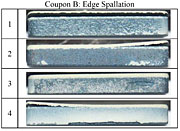- Number 332 |
- March 7, 2011
Testing high temperature coatings at NETL

Edge and surface photographs
of a coupon after cumulative
400 thermal heat treatment
hours at 1100°C
The new high efficiency turbines being designed for power plants will require that certain components withstand very high temperatures, from about 1425 to 1760 °C (2600-3200 °F). Currently, there is no commercially available functional metallic-based system that can maintain a reasonable level of compositional and micro-structural stability for prolonged exposure above 1050 °C (1920 ºF). As a result, alloys for high-temperature applications are often protected from surface degradation by either an overlay or a diffusion coating that contains a β-NiAl phase as a primary constituent. These β-containing coatings have a sufficiently high aluminum content to form a continuous scale layer of the slow-growing and highly stable Al2O3.
Thermally-grown oxides can serve as an effective barrier, protecting coated components from the process environment. However, as commercially applied diffusion or overlay bond coat systems are subjected to high temperatures for extended periods of time, rumpling of the bond coat surface can occur, causing induced stress and spallation of the coating. This ultimately leads to reduced turbine operating life. DOE’s National Energy Technology Laboratory has developed a micro-indentation technique that can be used to measure the mechanical properties of thermal barrier coatings applied to alloy coupons at high temperature in high moisture-containing environments to indicate the occurrence of internal debonding and/or spallation. Evaluations are performed using a spherical tungsten carbide indenter having a radius of 793.5 μm, combined with a piezoelectric actuator and load cell.
Results from these measurements are presented to the user as a surface map of layer stiffness response This mapping has been found to correlate very well with subsequent delamination events as shown in the image. Hence, this new approach can be used as a non-destructive assessment of the integrity of the coating layers, and if spallation/delamination is determined to be imminent, new coatings can be applied prior to full turbine blade failure.
[Linda Morton, 304.285.4543,
Linda.morton@netl.doe.gov]
